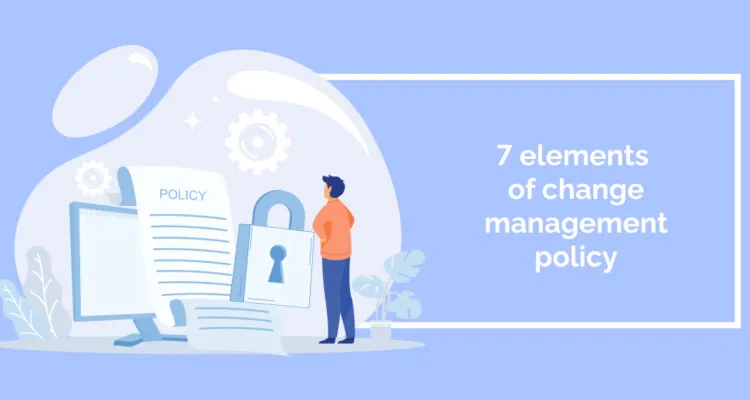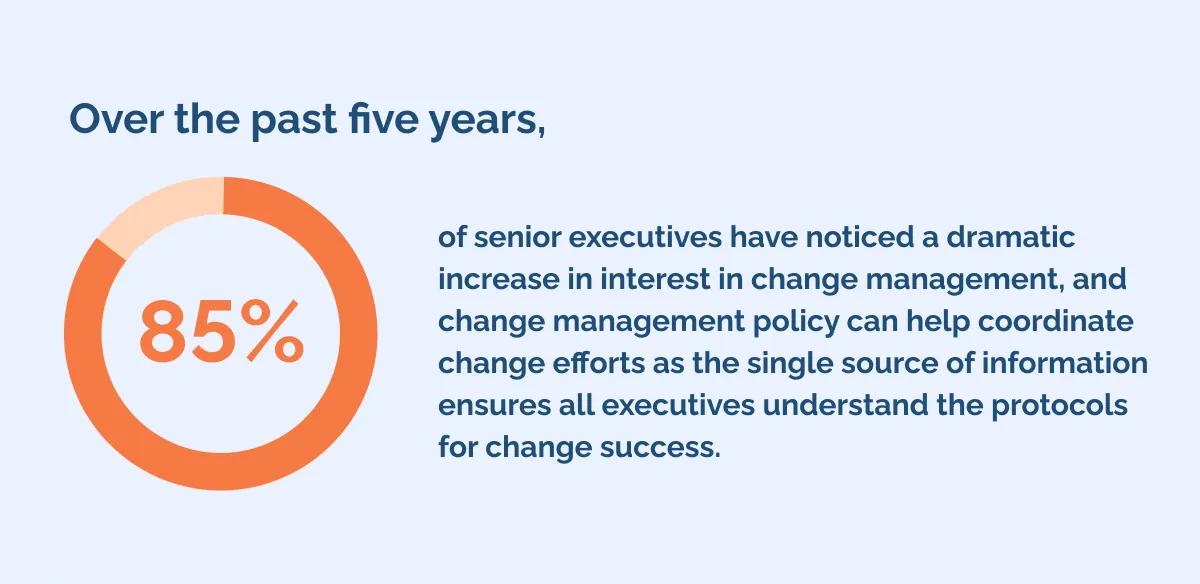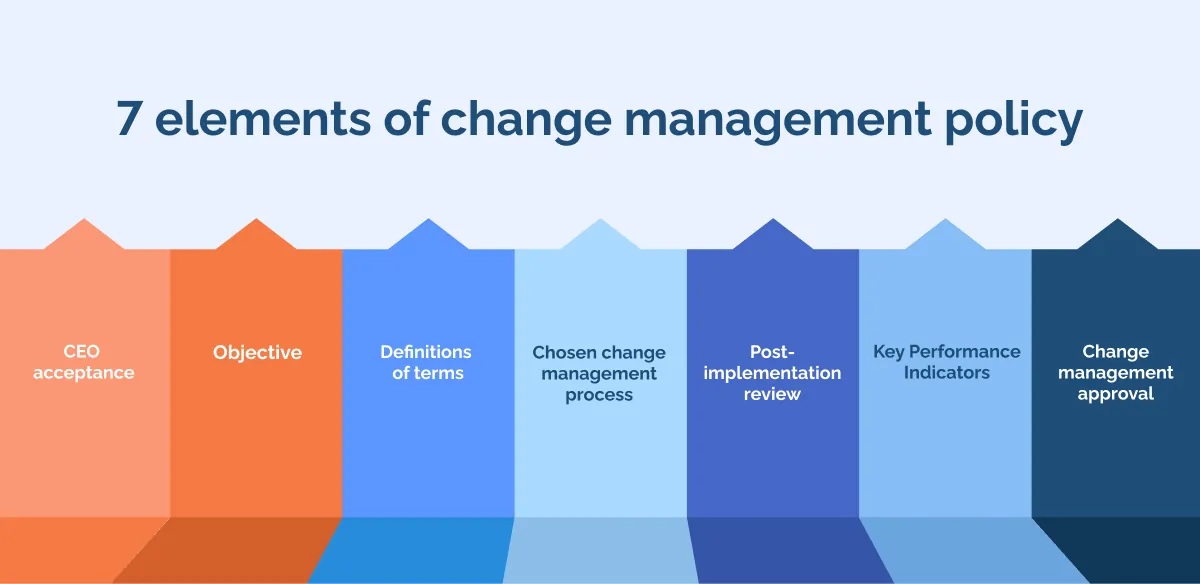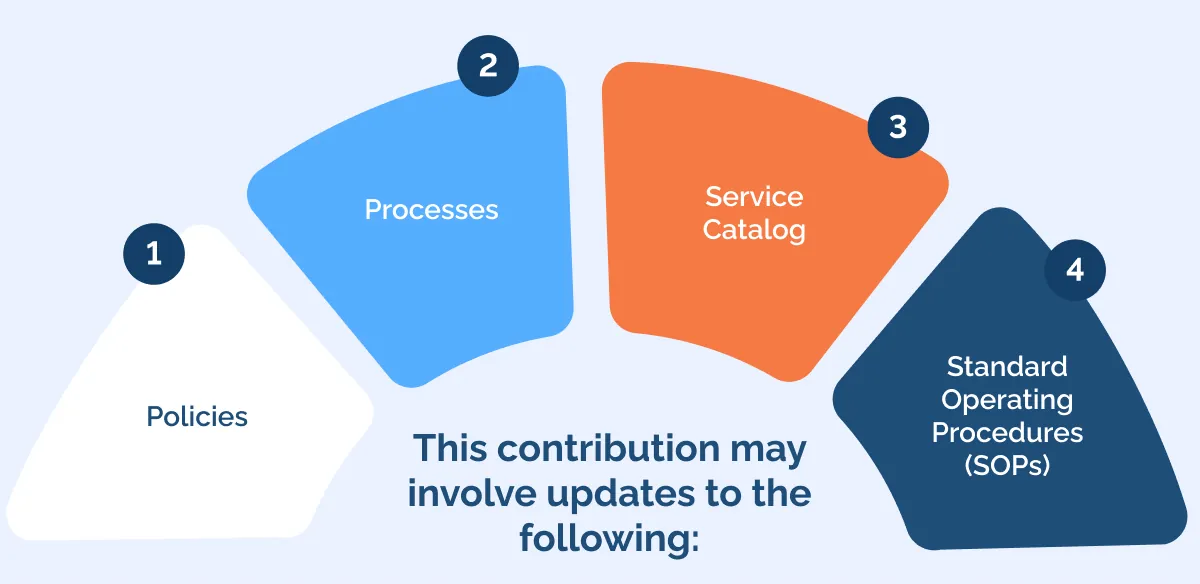
Change is complex, and a change management policy is the best way to tackle it while minimizing the negative impact on employees and optimizing positive implications for your organization.
Change management policy allows leaders to coordinate change processes and team members to follow the same employee experience management (EEM) practices in a unified way to ensure ROI within a successful digital transformation.
Over the past five years, 85% of senior executives have noticed a dramatic increase in interest in change management, and change management policy can help coordinate change efforts as the single source of information ensures all executives understand the protocols for change success.
This point shows that change management policy sees frequent use, and the benefits are clear because half of change initiatives fail and only 34% succeed since most organizations do not implement a policy for change management.
Change policy can help increase this number by coordinating change efforts and planning for unforeseen events.
This article will delve into the fundamental aspects of change management policy, encompassing its definition, significance, and the seven essential elements. It will also provide insights into the benefits of a well-established policy and discuss various change and release types.
What is a change management policy?
Change management policy ensures that all employees receive the same support to a high standard when navigating a digital transformation, especially when trying to learn to use new technologies, which often causes burnout and stress.
This policy focuses on standards by establishing the change management procedures and detailing the rules and responsibilities needed to approve the different types of changes to ensure the change initiative’s success.
Why do you need a change management policy?
A change management policy streamlines any digital transformation, ensuring it meets its aims promptly without negatively impacting employee experience.
Without a change management policy, attempts to provide staff support would be disorganized and less effective, as different staff would receive different types of support, promoting frustration, reducing employee retention, and delaying change initiative progress.
A change management policy ensures large-scale changes are successful, helping your organization make practical changes to technology, culture, and processes, highlighting its essential nature as one of your top policies for organizational success.
7 elements of change management policy
Every change management policy should contain seven elements to ensure successful planning, implementation, and review, beginning with CEO acceptance.
1. CEO acceptance
The CEO or other relevant C-suite must accept all change management policies before they are published and provide their signature and the date of signature. This signature provides oversight and ensures a unified change leadership approach and policy understanding.
2. Objective
The goal of change management policy is always to ensure the use of standardized methods and procedures for implementing beneficial changes in the Office of Technology Services (OTS). How you achieve this will differ slightly depending on your organization.
Your change management policy objective aims to handle service changes efficiently and promptly. The primary objectives usually include minimizing service disruptions, reducing back-out activities, and ensuring clear communication between IT and its customers.
To achieve this, the OTS of an organization outlines the change management policy in the document, with key principles as follows:
- All changes to any OTS-provided service must go through the change management process, regardless of source or type.
- The decision to authorize or reject a proposed change rests on the completed change management process, which includes a proper understanding of the associated risks.
- Each type of change (Standard, Normal, and Emergency) has specific submission, approval, and execution requirements outlined in this policy. These types include distinct levels of authorization and communication, along with rules for assessing and executing changes.
3. Definitions of terms
Everyone who reads the policy must understand every word to implement it properly.
A definition of terms establishes all the commonly used words and phrases included in the policy, so anyone who may not be familiar with them will understand their significance within the context of the policy.
Typically defined terms with a change management policy and examples of how to write their definitions include:
- Change: Change encompasses adding, modifying, or removing a configuration item with potential IT service impact, requiring management approval, enhancing processes, and reducing risks.
- Change management: Change Management is the process of controlling all changes’ lifecycle.
- Change management policy: The Change Management Policy is the guiding standard outlining procedures, rules, and authorization levels for approving different types of changes.
- Change proposal: A Change Proposal communicates significant changes, like introducing a new service and assessing risks, impacts, and feasibility before design activities commence.
- Change record: A Change Record contains all the details of a change, documenting its lifecycle. It is typically created based on a preceding Request For Change.
The definitions will vary in length depending on how complex the term is, but they should all be easy to understand for someone with no prior knowledge to allow them to grasp how they work within the policy.
4. Chosen change management process
This section begins with the objective of the change management process before defining which process leadership chose. The purpose helps provide a focus for implementing the process and a rationale for the choice.
The change process aims to oversee introducing a change into production by ensuring adherence to correct procedures, completion of proper documentation, thorough testing, and obtaining appropriate approvals.
The section splits into subsections covering three aspects of the overall change management process, including:
- Process overview
- Exceptions
- Processes
1. Process overview
The change management process begins in response to a service request or input from project management, release and deployment management, or incident and problem management.
Simultaneously, the change management process can offer input to other processes like project management, incident/problem management, and service strategy.
This contribution may involve updates to the following:
- Policies.
- Processes.
- Service Catalog.
- Standard Operating Procedures (SOPs).
2. Exceptions
All changes to any service provided by OTS must go through the change management process, regardless of source or type.
However, instances beyond OTS’s ownership and operational control, such as Software as a Service (“SaaS”), proprietary software code (e.g., SAP), electrical power grid infrastructure, or telecommunication infrastructure, may require an approved exception to this policy.
A written explanation from the relevant OTS Service Owner and approval from the OTS CIO or Deputy CIO is mandatory for system changes considered exceptions.
Additionally, updates, including the retirement of an exempted system or a three-year recertification cycle for exceptions, must be submitted by the respective OTS Service Owner for approval by the OTS CIO or Deputy CIO.
3. Processes
Processes to arrive at the chosen change management process are essential to ensure a systematic approach. First, the change management team must establish a standard change.
Establish a standard change
Establishing a Standard Change involves drafting a Standard Operating Procedure (SOP) detailing past successful implementations, ensuring repeatability and predictability.
After review by the Service Owner and approval by the Vertical Change Control Group, the SOP is published, marking the change as officially “Standard.” This systematic process ensures the approved management of standardized changes.
Standard change(s) deployment approval
Standard changes, exempt from vertical change control group approval, require notification within enterprise governance – Change management. The Office of Technology Services (OTS) follows specific guidelines for their execution.
This flow chart shows how the standard changes take place.
FLOW CHART
Adhering to approved timeframes set by the service owner, standard changes without an SOP follow the normal or high-priority change process until the criteria for “Establishing a Standard Change” are met.
Multiple Standard Changes are ideally released together, documented in a Schedule of Standard Changes. The outlined schedule guides the release, addressing concerns before execution and ensuring systematic management and communication within the OTS framework.
Deployment to production
As the change window begins, per the Schedule of Standard Changes, the assigned technical SME (subject matter expert) notifies service subscribers through the service owner-approved communication plan.
Subsequently, the SME executes approved SOPs for all changes, systematically testing each to align anticipated outcomes with expectations.
In case of testing issues, the SME employs approved troubleshooting techniques, ensuring a coordinated and effective process within the outlined framework for communication, execution, and testing procedures.
Successful deployment
After successfully implementing the change, the technical SME will use the service owner-approved communication plan to notify service subscribers/consumers that the changes are complete.
Following this communication, the change record will undergo updates to accurately reflect the successful completion of the schedule of standard change. This step ensures stakeholders receive confirmation of the concluded changes and that the documentation accurately mirrors the implementation status.
The systematic updating of the change record is crucial in maintaining transparency and accountability throughout the change management process.
Failed deployment
If disruptions occur during the release, creating an Incident becomes crucial. Following this, meticulous adherence to the incident management process is necessary for prompt issue resolution.
After resolving disruptions and completing changes, a thorough post-implementation review and root cause analysis are imperative. The findings should be documented and attached to the relevant ticket item, providing a detailed account of the resolution process and insights gained.
If a change results in an Incident, related standard operating procedures must undergo updates, followed by a comprehensive review and approval process. This step ensures prompt incident resolution, thorough analysis, and corrective actions to enhance future change implementations.
5. Post-implementation review
The objective of conducting a post-implementation review is to evaluate the progression of the change implementation and the outcomes achieved.
This process aims to establish a comprehensive historical record of the change and ensure thorough analysis of any encountered issues, facilitating the extraction of valuable lessons.
Process
Post Implementation Reviews (PIRs) are crucial in evaluating change implementation outcomes, with specific guidelines for each change type.
For standard changes/releases, an annual audit requires a meticulous review of a chosen sample subset, assessing factors like incidents, test execution, timing, and documentation adherence.
Regular changes/releases and high-priority releases undergo PIRs determined by the ECCG through the change approval process and annual audits, involving a decision on needing a total PIR.
Emergency changes mandate PIRs, including Root Cause Analysis, coordinated by the governing body. Additionally, any change resulting in an incident, outage, or deviation from expectations requires a mandatory PIR and root cause analysis.
This comprehensive process ensures continuous improvement in change management practices.
6. Key Performance Indicators
Key Performance Indicators (KPIs) aim to establish a robust framework for controlling processes by conducting regular quality assessments of the change management process.
The provided KPIs and metrics serve as specific and quantifiable indicators to continually assess the process’s quality. These indicators play a crucial role in ongoing optimization and enhancing the design of the process.
See the table below for examples of metrics to use to measure the success of your change management policy.
TABLES OF INFO LIKE IN SOURCE POLICY
Count and rate the Standard, Normal, High Priority, and Emergency Changes—approved, retroactively approved, successful, or unsuccessful.
Compare accepted to rejected RFCs as a percentage of Normal and High Priority Changes.
Evaluate Emergency Changes approved as a percentage of the overall Changes.
Assess changes successfully executed (per plan, no rollbacks) as a percentage of total changes within a specified time frame.
Analyze changes causing extended outages, major or critical Incidents, or Problems as a percentage of total changes in that period.
Examine changes completed in Production without documented approval before execution as a percentage of total changes within a given period.
7. Change management approval
The Change Management Approval process aims to articulate and elaborate on the decentralized approach to change management, utilizing the enterprise change control group.
This procedure ensures that the OTS is well-prepared to implement and support requested enterprise changes while supervising the Vertical Change Control Groups (VCCG) during the execution of local or vertical changes.
Enterprise Change Control Group (ECCG)
The enterprise change control group must oversee the entirety of the change management process for the enterprise. It executes the normal, high-priority, and emergency change management processes for enterprise-level changes.
Additionally, the ECCG coordinates impact analyses for each enterprise change request and makes final decisions regarding the deployment schedules for enterprise changes.
The ECCG is composed of the following members:
Enterprise change control group review and approval
The ECCG review and approval process meticulously evaluates all enterprise-level RFCs, guided by the enterprise governance architect.
Each RFC receives scrutiny for completeness, documentation availability, and awareness of affected units, including assessing the back-out strategy, change type assignment, and potential post-implementation review.
After this review, the PMO assigns changes to an ECCG meeting agenda. The compliance manager presents RFCs at the ECCG meeting, where readiness and priority are validated and approval details visible. The service owner certifies the information and communicates pending changes as planned.
For standard changes and procedures, the VCCG reviews repeatability, predictability, and risk impact before approval, ensuring thoroughness and considering past execution history.
VCCG certification through meeting minutes confirms standard change categorization. This comprehensive process ensures effective organization-wide change management.
Approval procedure for emergency change management
Emergency changes will follow the outlined emergency change processes mentioned earlier.
The ECCG receives notification, and the execution of the change will necessitate approval from a service owner. The CIO and deputy CIO hold the authority to grant singular approval for any change.
The table below shows the emergency change process.
When you ensure you include details in an accessible format, you increase the chances of all staff understanding your change management policy. You will also support their empowerment to implement it confidently and participate in the review, feedback, and improvement processes.
An effective change management policy ensures faster ROI on policy investment and successful digital transformations.
What are the benefits of a change management policy?
If you consider building one, you must know the eight main benefits of change management policy.
Ensures consistency
A change management policy provides a structured framework to handle changes consistently across an organization, avoiding ad-hoc or chaotic approaches.
When implementing a new software system, a change management policy ensures that the rollout process follows a consistent methodology across different departments, preventing variations in deployment approaches.
Minimizes disruptions
By defining processes and procedures, the policy aims to minimize service disruptions during changes, ensuring that operations continue smoothly.
Adherence to the change management policy during a scheduled server upgrade helps minimize disruptions by outlining detailed procedures, ensuring a seamless transition without affecting ongoing services.
Risk mitigation
It helps identify and mitigate risks associated with changes, ensuring that potential adverse impacts are assessed and addressed proactively.
Before implementing a major system update, the change management policy facilitates a risk assessment, identifying potential issues. For instance, testing the update in a controlled environment helps mitigate the risk of unexpected bugs impacting the live system.
Enhances communication
A well-defined policy facilitates communication between various stakeholders, ensuring everyone is on the same page regarding upcoming changes, their impact, and the expected outcomes.
The change management policy ensures transparent communication when introducing a new project management tool. Regular updates, training sessions, and documentation help stakeholders understand the changes, fostering a smooth transition.
Facilitates compliance
Certain industries and organizations have specific regulatory requirements. A change management policy helps ensure compliance with these regulations, avoiding legal issues and penalties by outlining disciplinary action for not following the policy.
In any enterprise organization, a change management policy ensures that any storage and alterations to employee records comply with state regulations. This proactive approach prevents regulatory violations and ensures staff data integrity.
Encourages continuous improvement
The policy establishes a framework for post-implementation reviews and analysis, fostering a culture of continuous improvement by learning from past changes.
After implementing a new workflow process, the change management policy initiates a post-implementation review. Insights from this review lead to adjustments, promoting a culture of continuous improvement in how the organization handles future changes.
Increases adaptability
Adaptability is crucial in a rapidly evolving business landscape, and agile leaders come out on top. A change management policy enables leaders to help their organizations adapt effectively to technological advancements, market changes, and other external factors.
In response to industry shifts, a company updates its sales strategies. The change management policy allows for swift adaptation by streamlining the process, enabling the organization to stay competitive in a dynamic market.
Builds accountability
Clearly defined roles and responsibilities in the policy build accountability, ensuring that individuals and teams are responsible for specific aspects of the change process.
The change management policy assigns specific responsibilities when launching a new website feature. Developers ensure code integrity while the marketing team communicates the changes externally. This clear accountability ensures a coordinated and effective implementation.
Change types and release types
The change management policy defines three change types (Standard, Normal, and Emergency) and four release types (Standard, Normal, High Priority, and Emergency) to accommodate various priority and impact levels.
These change types can help you understand how to incorporate different change types into your change policy.
Standard change/release
Standard Change/Release is a pre-approved, low-risk, and repeatable change using defined work instructions in a standard operating procedure (SOP).
SOPs receive reviews from the Service Owner, are pre-approved by the Vertical Change Control Group, and are ready for use by technical SMEs without further approval. SOPs grow over time based on repeat situations encountered by OTS.
Normal change/release
Normal change/release is a non-pre-approved change, not an emergency, and the change team can implement it during maintenance windows.
It follows the full change management process and handles service requests, project inputs, release and deployment management, and resolutions for Incident and problem management incidents.
Emergency change/release
Emergency change/release is a rapid deployment to resolve outages and severe business or security impact and to meet OLAs (operational level agreements that support SLAs).
It uses an abbreviated process, including a post-implementation review and root cause analysis. All resolutions for major and critical incidents follow the Emergency Change process.
High priority release
A high-priority release is a business-driven request to release a normal change, requiring implementation outside standard maintenance windows but not during operating hours (like Emergency Change). It follows the full Change Management Process, similar to a Normal Change.
Build a straightforward change policy to ensure success
Effective change management policies can transform an organization from a group of individuals to a cohesive team working toward the same organizational goals.
To achieve this, a change management policy must be detailed, comprehensive, and customized to your enterprise’s needs. However, all your efforts will go to waste if you don’t ensure the policy is accessible to every reader.
Many different disciplines and roles will read the change management policy, and it must be accessible and practical to follow. Suppose it is written simply with the fewest words and the least jargon where possible.
In that case, your organization will become agile, with all employees embracing change and striving toward innovation, which drives profits and long-term success.
WalkMe Team
WalkMe spearheaded the Digital Adoption Platform (DAP) for associations to use the maximum capacity of their advanced resources. Utilizing man-made consciousness, AI, and context-oriented direction, WalkMe adds a powerful UI layer to raise the computerized proficiency, everything being equal.








